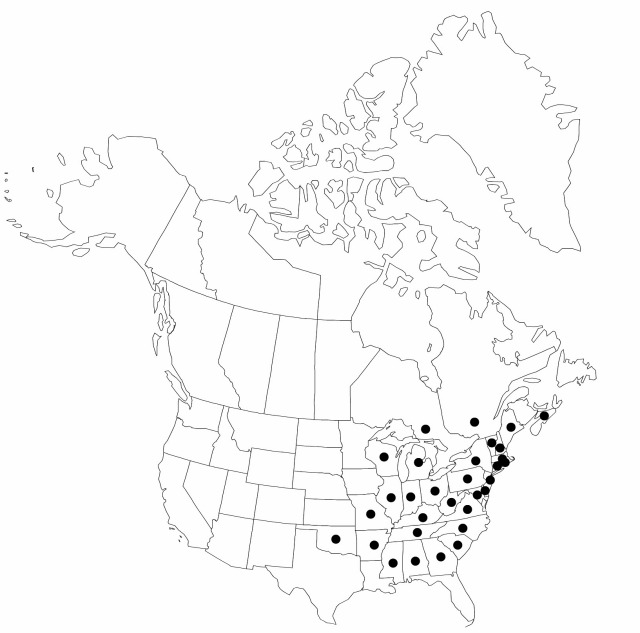Carex laxiflora
in J. Lamarck et al., Encycl. 3: 392. 1792.
Culms densely tufted, lateral or central, ascending or lax to decumbent, 39–47 cm × 0.8–2 mm. Leaves: basal sheaths light-brown; sheaths 6–22 mm; blades ascending, midrib and 2 lateral-veins developed, occasionally slightly corrugated, 19–25 cm × 5–26 mm, blades of overwintering leaves smooth or, rarely, sparsely papillose abaxially. Inflorescences: peduncles of proximal spikes erect, 0–3.4 cm, of lateral spikes 1.4–3.3 (–5.3) times as long as spikes they subtend; of terminal spikes 1–2.2 cm. Bracts 7.2–17.5 cm × 2–8 mm, bract blade of distal lateral spikes linear, narrower than spikes, widest bract blade of distalmost lateral spike 0.5–3.4 mm wide. Spikes (3–) 4 per culm; lateral spikes 9–33 × 3.2–4 mm; terminal spike linear to clavate, 23–24 (–34) × 1.5–3 mm. Pistillate scales 2.5–3 × 1.2–1.5 mm, apex acute or apiculate. Staminate scales 3–3.5 × 1–1.5 mm, oblongovate, margins white-hyaline or brownish, apex obtuse or acute. Anthers 2.6–3 mm. Perigynia 3–20 per spike, usually separate, ratio of longer lateral spike length to perigynia number 1.9–3.4, ascending, conspicuously (22–) 25–32-veined, (2.6–) 3.2–4.1 (–4.6) × 1.2–1.6 mm; beak straight, 0.5–1.4 mm. Achenes broadly ellipsoid, 1.8–2.2 (–3.4) × 1–1.4 mm. 2n = 40.
Phenology: Fruiting spring–early summer.
Habitat: Dry or moist, deciduous or mixed deciduous-evergreen forests, higher elevations southward
Elevation: 0–1000 m
Distribution

N.S., Ont., Que., Ala., Ark., Conn., Del., Ga., Ill., Ind., Ky., Maine, Md., Mass., Mich., Miss., Mo., N.H., N.J., N.Y., N.C., Ohio, Okla., Pa., R.I., S.C., Tenn., Vt., Va., W.Va., Wis.
Discussion
The Carex laxiflora complex contains a wide array of phenotypic variation and deserves further research. F. J. Hermann (1938) proposed the name C. laxiflora var. serrulata; however, among the numerous specimens of C. laxiflora we studied, the key characteristic of ciliate-serrulate bract-sheaths varied greatly.
Selected References
None.
Lower Taxa
"shortened" is not a number."-3.3(-5.3)timesaslongasspikes" is not declared as a valid unit of measurement for this property.
